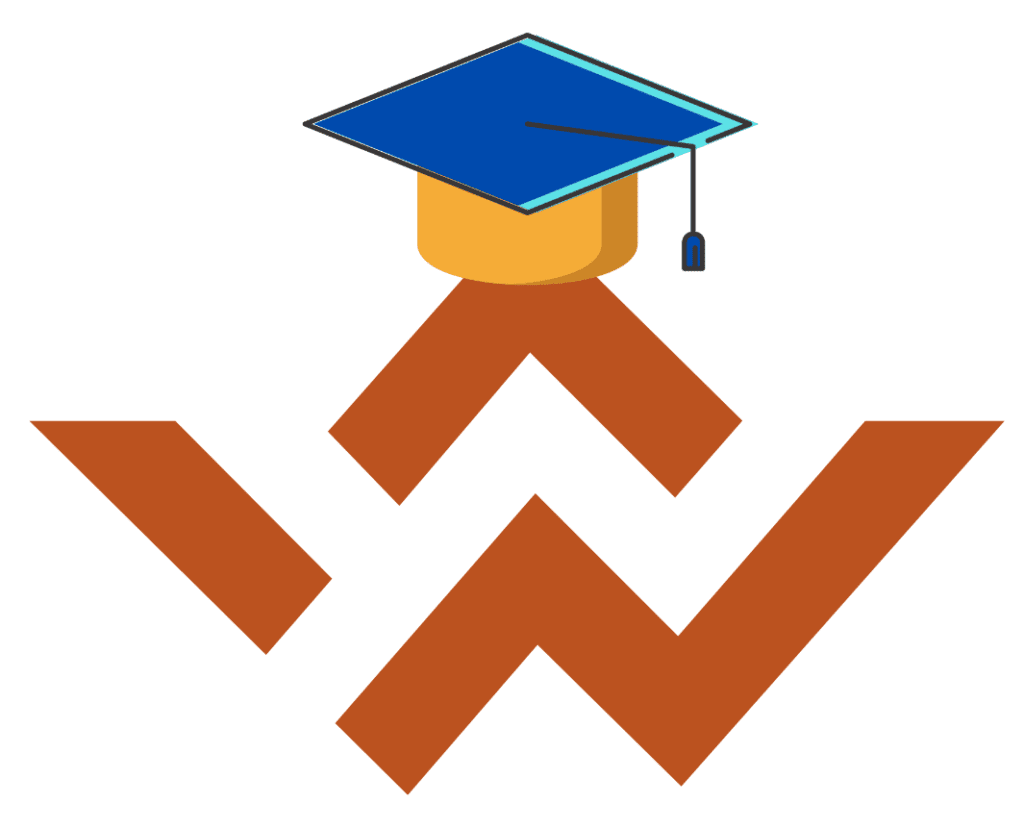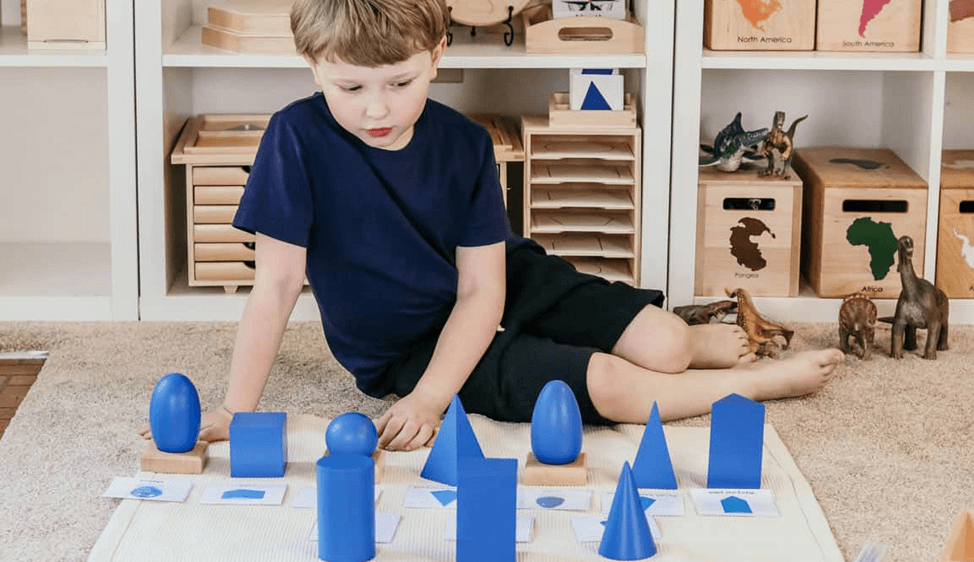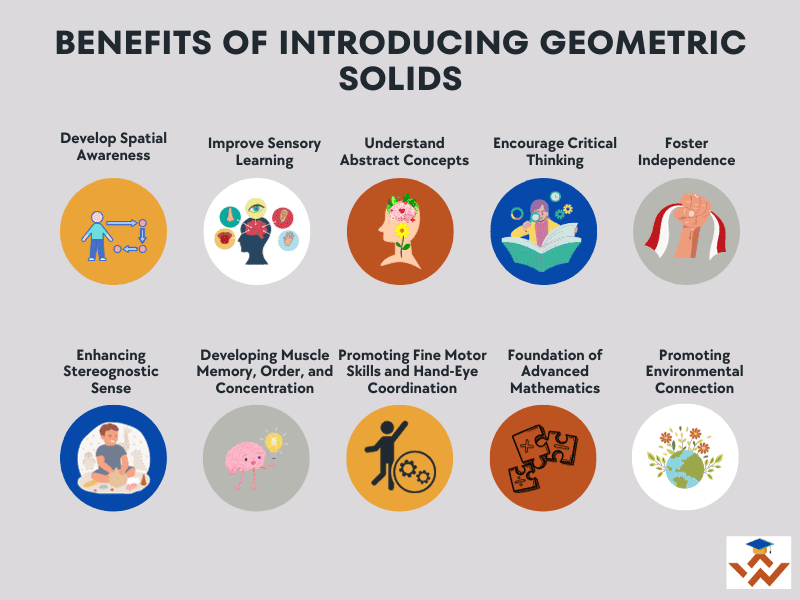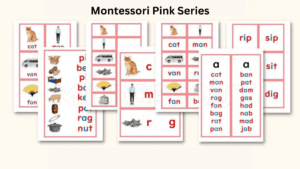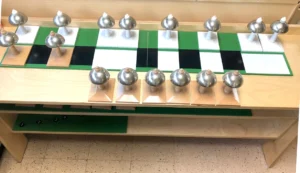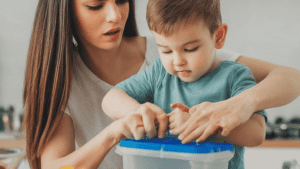This Sensorial lesson is designed for 3-6 year old children to help them learn about different shapes using Montessori Geometric Solids. It is one of the versatile Montessori activity which can be clubbed with more complex activities. Let’s learn more about it.
What are Geometric Soilds?
In Montessori education, geometric solids are three-dimensional objects that not only enable children to touch, feel, and handle them, but also empower them to cultivate a profound comprehension of spatial relationships. These solids come in various shapes, such as cubes, spheres, cylinders, cones, rectangular prisms, and triangular prisms. Each geometric solid has distinct attributes, such as the number of faces, vertices, and edges.
These shapes play a crucial role in teaching children about spatial concepts and shapes.
Benefits of Introducing Geometric Solids in Early Education
Montessori Geometric Solids offer more than just a grasp of shapes: they contribute to holistic development. Here’s why:
- Develop Spatial Awareness: By interacting with these three-dimensional objects, children learn how different shapes occupy space in various ways. This helps them develop spatial reasoning skills that are crucial for activities like reading maps, understanding diagrams, and navigating the physical world.
- Improve Sensory Learning: Geometric solids stimulate several senses, such as touch and sight. This sensory experience aids in the development of sensory perception and cognitive skills, fostering a more holistic learning process.
- Understand Abstract Concepts: Concrete experiences with geometric solids allow children to grasp abstract mathematical concepts more easily. For instance, learning about volume, shape attributes, and symmetry becomes much more intuitive through hands-on exploration.
- Encourage Critical Thinking: As children manipulate geometric solids, they’re encouraged to think critically about the relationships between shapes, sides, and angles. This promotes problem-solving skills and logical thinking.
- Foster Independence: Montessori education places a strong emphasis on independent learning. Geometric solids provide children with the tools to explore and learn on their own, at their own pace.
- Enhancing Stereognostic Sense: By engaging with these shapes, the child’s stereognostic sense is nurtured, enabling them to discern and identify the form and essence of objects through touch.
- Developing Muscle Memory, Order, and Concentration: Working with geometric shapes contributes to the development of the child’s muscle memory, organizational skills, and concentration abilities.
- Promoting Fine Motor Skills and Hand-Eye Coordination: Manipulating these shapes supports the refinement of fine motor skills and the coordination between hand and eye movements.
- Laying the Foundation for Advanced Mathematics: This early exposure lays the groundwork for the child to confidently approach more intricate mathematical concepts in the future.
- Promoting Environmental Connection: These shapes aid children in forming a meaningful bond with the objects surrounding them, cultivating a more profound comprehension of their environment.
Materials in Geometrics Solid Set
The Montessori Geometric Solids Set consists of various three-dimensional shapes, each with distinct attributes. Let’s explore these captivating solids:
- Cube: A cube is a solid shape with six square faces. It looks like a box, and all its sides are the same length. It has eight corners (vertices) and twelve edges.
- Sphere: A sphere is a perfect round 3D shape, like a ball. It has no edges or corners. When you roll a sphere, it moves smoothly.
- Cylinder: A cylinder is like a can or a tube. It has two circular faces and a curved surface that connects the circles. Imagine a soup can or a drinking glass.
- Rectangular Prism: This shape looks like a box, but it can be longer or shorter. It has six faces, where two opposite faces are rectangles, and the other four faces are squares.
- Square-Based Pyramid: Picture a pyramid like the Great Pyramid in Egypt. The bottom is a square, and the sides slope up to meet at the top.
- Triangular-Based Prism: This is like a rectangular prism, but the top and bottom faces are triangles instead of rectangles. It looks a bit like a Toblerone chocolate bar!
- Ovoid: An ovoid is a shape that’s similar to an egg. It’s elongated and rounded, sort of like a stretched-out sphere.
- Ellipsoid: An ellipsoid is a 3D shape that’s also like a stretched-out sphere, but the sides are a bit flatter.
- Cone: A cone is a shape that comes to a point at the top and has a flat circular base at the bottom. Think of an ice cream cone!
- Triangular Prism: Just like a rectangular prism, but this one has triangles on the top and bottom instead of rectangles. It’s like a prism with triangular ends.
Also Check: Montessori Dressing Frames
Points of Interest
- Touch and Feel of the shapes
- Different types of shapes
- Some have corners and some don’t
Control of Error
Every shape is unique.
How to Present Montessori Geometric Solids to the Child?
Before presenting Geometric solids to the child, introduce them with the concept of 2D shapes.
- Invite the child to bring Geometric Solids kit to the table.
- Tell the child that today, they will learn about different shapes.
- By using 3-period lesson, introduce one shape starting with the sphere.
- Tell the child, this is sphere, it is round in shape and has no side or corner.
- Ask the child to hold sphere in their hand and feel it by revolving it in their hands.
- Now, ask the child by asking “which shape is this?” Let the child answer it.
- While introducing each shape, repeat its name several times.
- Once the child is familiar with the shape, ask them to name its features mentioned in step 4.
- Repeat if needed.
- Similarly, repeat step 3-9 with other 9 shapes.
Once the child is introduced with all the shapes, let them try by their own.
Also read, Montessori Bead Bars
Activities with Geometric Solids
Here are five activities related to Montessori geometric solids:
- Shape Sorting: Provide a collection of Montessori geometric solids and corresponding cards with their names and images. The child’s task is to match each solid with its correct card. This activity enhances shape recognition and classification skills, promoting cognitive development and critical thinking.
- Mystery Bag: Blindfold the child and place a geometric solid in their hand. Using only their sense of touch, the child boldly explores the attributes of the shape without relying on their vision. Then, they try to identify the solid based solely on their tactile experience. This activity sharpens sensory perception, fine-tunes tactile skills, and encourages verbal expression.
- Constructive Building: Offer the child a variety of geometric solids and let them use their imagination to build structures. They can create towers, bridges, or even more complex designs. This hands-on activity fosters creativity, spatial thinking, and problem-solving skills as they experiment with balance and stability.
- Comparative Analysis: Present two or more geometric solids to the child and encourage them to compare the attributes of each. For example, they could compare a sphere and a cube, discussing differences in the number of faces, edges, and vertices. This activity enhances critical thinking, logical reasoning, and the ability to identify and articulate distinctions.
- Storytelling with Solids: Use the geometric solids as characters in a story. Assign each solid a personality and role in the narrative. The child can manipulate the solids while creating a tale, boosting their language skills, imagination, and engagement with the shapes.
These activities not only make learning about geometric solids enjoyable but also foster a holistic development of skills, including cognitive, sensory, motor, and language abilities.
FAQs Related to Montessori Geometric Solids
1. How many geometric solids are there in Montessori?
In Montessori education, there are 10 geometric solids. These include the cube, sphere, cylinder, rectangular prism, square-based pyramid, triangular-based prism, ovoid, ellipsoid, cone, and triangular prism. These solids play a significant role in fostering children’s understanding of spatial concepts and three-dimensional shapes, enhancing their sensory perception and cognitive development.
2. What are geometric solids in Montessori?
In Montessori education, geometric solids are 3D objects used to teach spatial concepts and shapes. They offer hands-on learning, helping children understand shapes like cubes, spheres, cylinders, and more. These solids develop spatial intelligence, fine motor skills, and cognitive abilities for future learning.
3. What are the benefits of geometric solids Montessori?
The use of geometric solids in Montessori education has numerous advantages. They foster hands-on learning, aiding children in comprehending shapes like cubes, spheres, cylinders, and more. These solids develop spatial intelligence, refine fine motor skills, and enhance cognitive abilities, laying the groundwork for future learning in mathematics and other subjects.
